Nordisk Films Kompagni or Nordisk Film is a Danish film company, established in 1906 by filmmaker Ole Olsen. It is the fourth oldest film studio in the world behind the Gaumont Film Company, Pathé, and Titanus, but the oldest continuously active. Olsen started his company in the Copenhagen suburb of Valby under the name Ole Olsen's Film Factory but soon changed it to the Nordisk Film Kompagni.
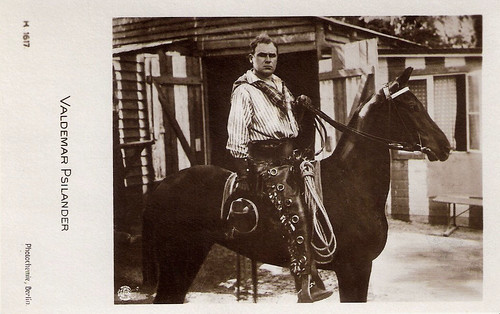
German postcard by Photochemie, Berlin, no. K 1617. Photo: Nordisk. Publicity still of Valdemar Psilander in Manden uden Fremtid/The man without a future (Holger-Madsen, 1916).

German postcard by Photochemie, Berlin, no. K. 1920. Photo: Nordisk Films. Gunnar Tolnaes in the Danish film Pjerrot (Hjalmar Davidsen, 1917).
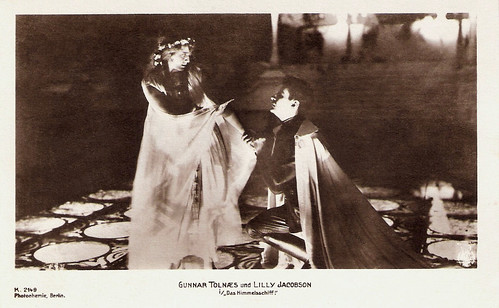
German postcard by Photochemie, Berlin, no. K. 2149. Photo: Nordisk. Publicity still for Himmelskibet/Das Himmelschiff (Holger-Madsen, 1918) with Lilly Jacobsson as Marya, the Martian leader's daughter, and Gunnar Tolnaes as Avanti Planetaros.
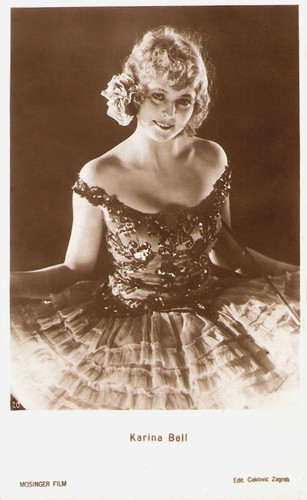
Yugoslavian postcard by Edit. Cakovic, Zagreb, no. 3747/1. Photo: Mosinger Film. Publicity still for Klovnen/The Clown (A.W. Sandberg, 1926) with Karina Bell.
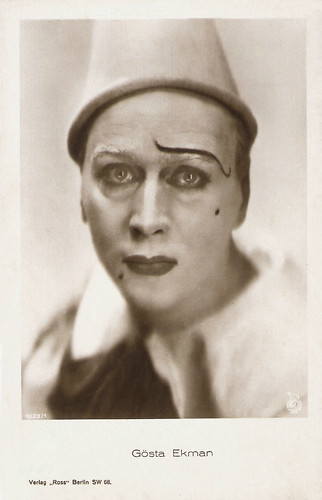
German postcard by Ross Verlag, no. 1623/1, 1927-1928. Photo: Nordisk. Publicity still for Klovnen/The Clown (A.W. Sandberg, 1926) with Gösta Ekman.
In 1905, former circus impresario Ole Olsen (1863-1943) opened Biografteateret (The Biograph Theatre) - one of the first cinemas in Denmark - at Vimmelskaftet 47 in Copenhagen. A year later, Olsen began to produce films under the name of 'Ole Olsen’s Film Factory'. The first film is called Duer og måger/Pigeons and Sea Gulls (1906), a two minute reportage. However, right from the beginning dramatic films were made too – often starring the multi-talented draftsman, Robert Strom Petersen. 'Nordisk Films Kompagni' was officially founded on 6 November 1906. By the end of the year, the company has established offices at Vimmelskaftet, studios at a garden allotment in Valby, a copying lab in Frihavnen, an affilitate in Germany, an agent in Sweden – and a polar bear atop a globe as the company’s trademark.
Affiliates were established in Vienna and London in 1907. The film Løvejagten/Lion Hunting (Viggo Larsen, 1907) sold 256 copies and was very successful. However, as Ole Olsen refused to obey Minister of Justice, Alberti’s order to halt the shooting of Løvejagten in the wake of an animal cruelty charge, he lost his cinema license for 'Biografteatret'. Olsen just slipped the film across the border and premiered it in Sweden. Løvejagten/Lion Hunting was a huge international success and set Nordisk on its path to glory.
Nordisk continued to grow rapidly. In 1908, Studio 1 in Valby was opened, and the New York affiliate, 'Great Northern Film Company', was established. The opening of Studio 2 in Valby followed in 1910. The Aarhus-based company 'Fotorama' introduced multi-reel films with Den hvide slavehandel/The White Slavery Trade (1910). Ole Olsen adapted the idea by copying the Fotorama-film nearly shot by shot (and adding 100 meters). August Blom directed this film, which was also called Den hvide Slavehandel.
The same team of Løvejagten, writer Arnold Richard Nielsen, director/star Viggo Larsen and cinematographer Axel Graatkjær (Axel Sørensen), had already made a film titled Den hvide Slavinde (Viggo Larsen, 1907), about women being kidnapped and forced to prostitution.
Blom's lurid piece of sensationalism set off another international film fad, caused all sorts of rumpus over censorship and even contributed to a change in the law in the US (the Mann Act). A year later, Olsen committed Nordisk Films Kompagni – as the first company in the world to produce multi-reel films of approx. 45 minutes duration. In the same year, Blom directed the sequel Den hvide Slavehandels sidste Offer, starring Clara Wieth Pontoppidan.
Nordisk Film became a public company, and Ole Olsen acquired the title of managing director (1911-1922). The actor Valdemar Psilander appeared in his first Nordisk Film feature, Ved fængslets port/Temptations of a Great City (August Blom, 1911). At the end of 1916, he had made more than eighty Nordisk Film features and was considered to be one of the greatest (and best paid) film stars of his time. Yet by the end of 1916, Psilander was demanding a salary of DKK 250,000 (34,000 EUR), which forced Nordisk Film into decline. The following year, Psilander suddenly passed away. Other major Nordisk film stars were Olaf Fønss, Clara Wieth Pontoppidan and the Norwegian Gunnar Tolnaes. Asta Nielsen also made two of her total of four Danish films for Nordisk Film: Balletdanserinden/The Ballet Dancer (August Blom, 1911), and Mod Lyset/Towards the Light (Holger-Madsen, 1919).
In 1912, Studio 3 in Valby was opened, and in 1914 Studio 4. Carl Th. Dreyer became a screenwriter and script consultant at Nordisk. In 1918, he directed his first film Præsidenten/The President, which premiered in Sweden in 1919 and Denmark in 1920. His ambitious film, Blade af Satans bog/Leaves from Satan’s Book premiered in 1921.
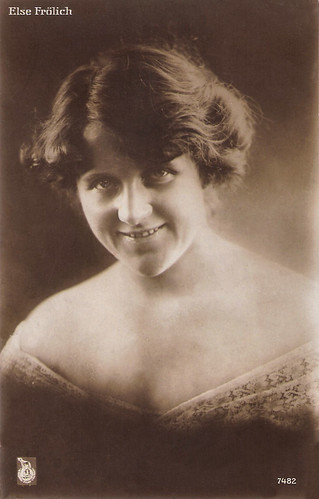
Else Frølich/Else Frölich. German postcard, no. 7482. Photo: Nordisk.
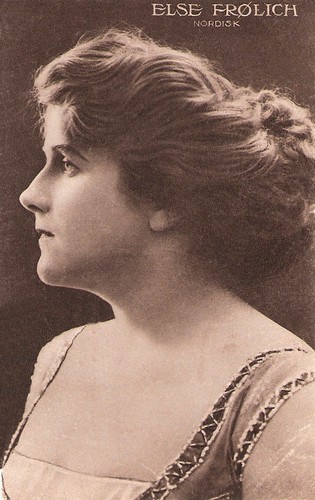
Else Frølich/Else Frölich. Danish postcard. Photo: Nordisk.

Austrian postcard by Edition Projectograph A.G., no. B.K.W.I. Kino 25. Photo: publicity still from Gæstespillet/Guest Game (Eduard Schnedler-Sørensen, 1913).
In the 1910s, Else Frølich/Else Frölich (1880-1960) was one of the leading actresses of the Danish Nordisk Company. She played in many Nordisk films and was often paired with the biggest male star of those years, Valdemar Psilander (1994-1917), such as in the beautifully restored Evangelimandens liv/The candle and the moth (Holger-Madsen, 1915). Frölich also often played in vehicles designed for herself.
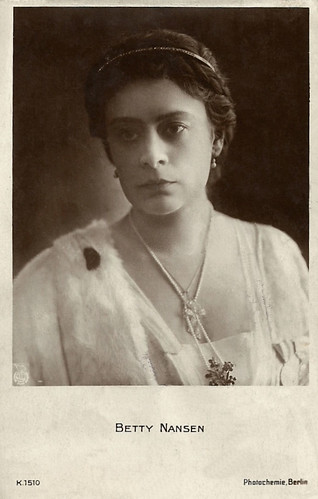
German postcard by Photochemie, Berlin, no. K 1510. Photo: Nordisk Films.
Betty Nansen (1873-1943) was a Danish stage and film actress who worked from 1913 on with prominent directors like August Blom, Holger Madsen and Robert Dinesen. Later she became the director of the theatre that still carries her name, the Betty Nansen Theatre.
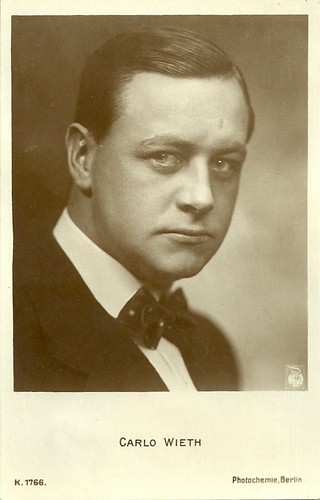
German postcard by Photochemie, Berlin, no. K. 1766. Photo: Nordisk.
Carlo Wieth (1885-1943) was a Danish actor, who starred in Danish and Swedish silent cinema of the 1910s and early 1920s, often paired with his then wife Clara (Pontoppidan) Wieth. After his start at Kinografen with Ekspeditricen/Salesgirl (August Blom, 1911), he played in some 18 films for Nordisk Film. With his somewhat boyish appearance and his fresh but gentle acting style, he soon became a popular actor.
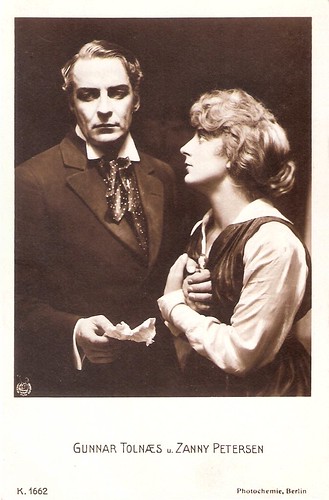
German postcard by Photochemie, Berlin, no. K. 1662. Photo: Nordisk. Publicity still for Pjerrot/Pierrot (Hjalmar Davidsen, 1917) with Zanny Petersen and Gunnar Tolnaes.
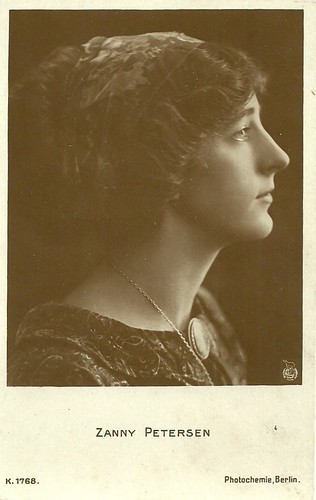
German postcard by Photochemie, Berlin, no. K. 1768. Photo: Nordisk Film.
Zanny Petersen (1892-1976) was a Danish stage and screen actress, who starred in Danish silent film since 1911. Between 1912 and 1917, she appeared in 40 films for Nordisk Film.
In 1914, the peak of silent film production at Nordisk Films Kompagni was reached. 143 fiction and 46 non-fiction features were produced that year, and more than 7000 copies were sold. A year later, Studio 5 in Valby was opened, but the following year the New York affiliate was shut down.
World War I badly affected film distribution in Europe. The Russian market closed its borders due to the 1917 Revolution. Ole Olsen relinquished his German interests, now including sixty cinemas, a production company and various assets with a cumulative share capital of 30 million marks. Production was in decline and Nordisk Film lost millions.
Talented people left the company, including Lau Lauritzen, who directed more than 200 Nordisk Film faces. At Palladium, he created the biggest Danish film success of the 1920s: Fy og Bi (Fyrtårnet og Bivognen), the most famous comedy couple of the European silent cinema. Long Carl Schenstrom and short Harald Madsen became a hit with their short slapstick films, known under such different names as Pat & Patachon, Long & Short or Watt & Half-Watt.
A.W. Sandberg, who had been a successful director at Nordisk Film since 1914, became head of the production department in 1922. Throughout the 1920s, he directed a number of huge and expensive costume dramas, including the famous Charles Dickens’ adaptions, David Copperfield (A.W. Sandberg, 1922) and Lille Dorrit/Little Dorrit (A.W. Sandberg, 1924) with Karina Bell.
In 1923, H. Bloch-Jespersen became managing director of Nordisk Films Kompagni (1924-1926). From 1926 on, Nordisk Films Kompagni was controlled by the board. In 1928 Nordisk Films Kompagni suspended payments. At a general meeting it was decided that the company should be liquidated. In 1929 a wealthy stockbroker, Carl Bauder – the majority shareholder of both Nordisk and the Palads Teatret cinema since 1926 – acquired all the assets and reorganised the company under the name ‘Nordisk Films-Kompagni af 1929’. The company was known as ‘Nordisk Tone-film’ until the end of 1935, after which it reverted to its original name, Nordisk Films Kompagni.

German postcard by Photochemie, no. K. 1913. Photo: Nordisk Films. Gunnar Tolnaes in Pjerrot (Hjalmar Davidsen, 1917), with Ulla Nielsen as The Child.

German postcard by Photochemie, Berlin, no. K. 3008. Photo: Nordisk. Lilly Jacobson in Maharadjahens Yndlingshustru/The Maharaja's Favourite Wife (Max Mack, 1917).

German postcard by Ross Verlag, no. 50/1. Photo: Deutsch Nordische Film Union / Nordisk. Gunnar Tolnaes in Maharadjahens Yndlingshustru/The Maharaja's Favourite Wife (Max Mack, 1917).
Gunnar Tolnaes (1879-1940) had his most famous performance as an Indian prince in the Danish orientalist melodrama Maharadjahens Yndlingshustru/The Maharaja's Favourite Wife (Max Mack, 1917), with Lilly Jacobson. It was so popular that it had a Danish sequel in 1919, and a German sequel in 1921.
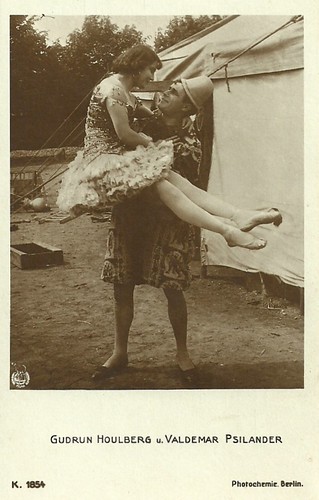
German postcard by Photochemie, Berlin, no. K. 1854. Photo: Nordisk Films. Valdemar Psilander and Gudrun Houlberg in Klovnen/The Clown (A.W. Sandberg, 1917).

German postcard by Photochemie, Berlin, no. K.1915. Photo: Nordisk Films. Valdemar Psilander in Der gefesselte Sieger (The conqueror in chains), the German release title for Hvorledes jeg kom til filmen/The Mute (Robert Dinesen, 1919). Psilander plays a star of the silent pictures, so basically himself.
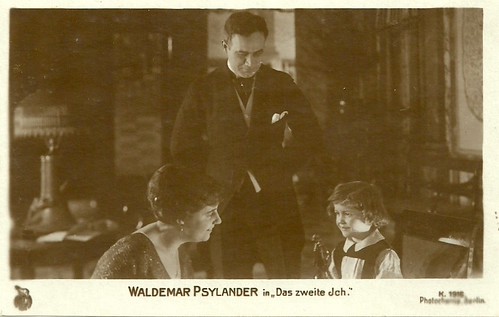
German postcard by Photochemie, Berlin, no. K. 1916. Photo: Nordisk Films. Valdemar Psilander and Ebba Thomsen in Das zweite Ich, German release title for Lykken/The Road to Happiness (Holger-Madsen, 1918).
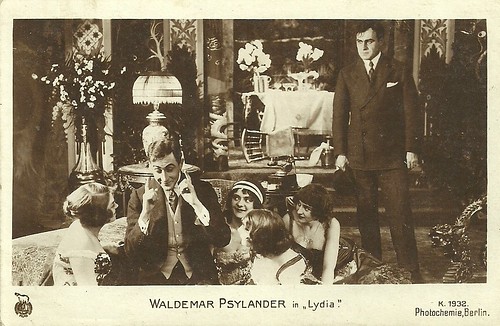
German postcard by Photochemie, Berlin, no. K. 1932. Photo: Nordisk Films. Valdemar Psilander in Lydia (Holger-Madsen, 1918).
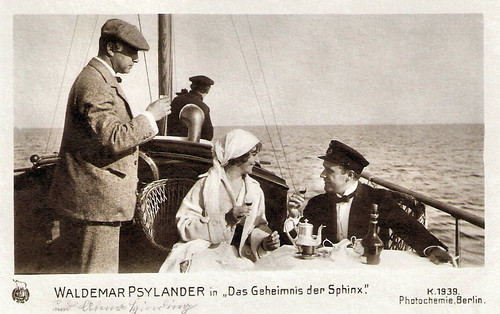
German postcard by Photochemie, Berlin, no. K. 1939. Photo: Nordisk Films. Valdemar Psilander in Das geheimnis des Sphinx, German release title for the Danish silent film Sfinxens Hemmelighed/The Secret of the Sphinx (Robert Dinesen, 1918).

German postcard by Photochemie, Berlin, no. K. 1944. Photo: Nordisk Films. Valdemar Psilander in Rytterstatuen/For the king's statue (A.W. Sandberg, 1919). The German title is Um das Bild des Königs.

German postcard by Photochemie, Berlin, no. K. 2628. Photo: Nordisk Films. Publicity still of Valdemar Psilander and Gudrun Houlberg-Nissen in Kærlighedsleg/Der Ewige Rausch/Love (A.W. Sandberg, 1918).
Valdemar Psilander (1884-1917) was the most popular male actor in the Danish cinema of the 1910s. The charismatic Psilander took the German, Russian and Hungarian audiences by storm. At Nordisk he would play in six years in 83 films. Only 32 years old, Valdemar Psilander passed away in 1917. At the peak of his career. Some say he died of a cardiac affliction, others say it was suicide.
Before, during and after the Nazi-German occupation of Denmark, Germany was one of the Danish film industry’s main trade partners. The scarcity of American films during the occupation opened up opportunities for Danish and German films. Carl Bauder, Nordisk Film’s shrewd owner, attempted unsuccessfully to monopolise German film distribution during the early years of the occupation. He failed because Nordisk Film was probably considered insufficiently pro-German. Like everyone else in the Danish film industry, Nordisk Film did business with the Germans during the occupation. Nordisk Film’s factory in the Frihavnen district of Copenhagen had a contract to copy German films, Nordisk Film rented out staff to produce the weekly newsreel Ugerevyen, and the company also exported Danish films to Germany.
During the occupation, Germans bombed the film studios in Valby, and Kino-Palæet (Nordisk Film’s cinema operating under Bauder’s licence) suffered extensive damage after being hit. In 1946, the rebuilt studio 4 was reopened. Erik Balling and Ove Sevel were employed as assistant directors. Balling later became director, screenwriter, producer and in 1957, his film Qivitoq (Erik Balling, 1957) was nominated for an Oscar. He became managing director of Nordisk Films Kompagni A/S from 1957 till 1989. In 1968, he had a box office hit with the comedy Olsen BandenThe Olsen Gang (Erik Balling, 1968). Two years later, he directed Huset på Christianshavn/Friends and Neighbours (Erik Balling, 1970-1977), a TV series in 84 episodes and the first fiction of the studio produced specifically for TV. While other film production companies shut down, Nordisk Film profited greatly on the TV series and avoided cutting down staff.
In the period 1971-1981, an 'Olsen Banden' film was produced every summer. The Olsen Gang became one of Denmark’s greatest film hits ever. In 1972, Studio 3 was rebuilt and became the biggest studio in Valby. Erik Balling made Matador/Monopoly (1978-1982) a TV series of 24 episodes which became the greatest TV success in Denmark to date. New directors such as Bille August, Kaspar Rostrup and Nils Malmros were making award-winning films at Nordisk.
In 1984, the young director Lars von Trier directed his first feature Forbrydelsens Element/The Element of Crime. The film won the Grand Prix du technique, Cannes, seven Danish Robert statuettes, and other awards. Another award winner was Tro, Håb og Kærlighed/Twist and Shout (Bille August, 1984). In 1987 followed Babettes Gæstebud/Babette’s Feast (Gabriel Axel, 1987), starring Stéphane Audran, which won the Academy Award for Best Foreign Film (1988), the first ever Danish Oscar.
The following year, Pelle Erobreren/Pelle the Conqueror (Bille August, 1988) won also the Academy Award for Best Foreign Film (1989), plus the Palme d´Or in Cannes, a Golden Globe Award, and eight Robert statuettes. Europa (Lars von Trier, 1991) with Barbara Sukowa and Jean-Marc Barr, was also awarded many prestigious prizes, including the Prix de la Commision & Special Prize in Cannes.
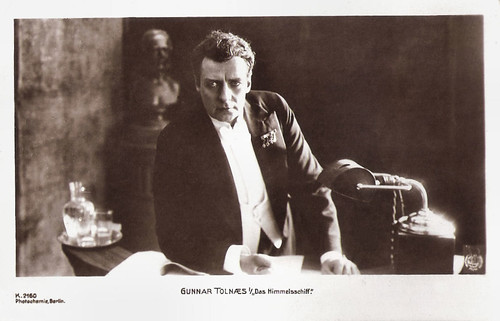
German postcard by Photochemie, Berlin, no. K. 2160. Photo: Nordisk. Publicity still for Himmelskibet/Das Himmelschiff (Holger-Madsen, 1918) with Gunnar Tolnaes as Avanti Planetaros.
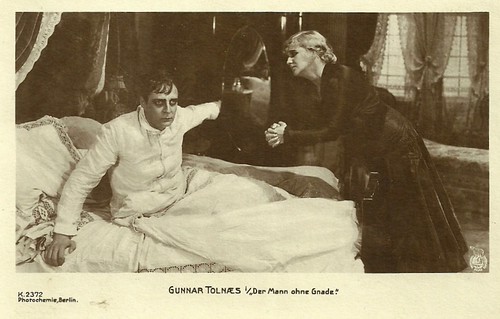
German postcard by Photochemie, no. K. 2372. Photo: Nordisk Films. Gunnar Tolnaes in Den Retfærdiges Hustru (A.W. Sandberg, 1917), co-starring Else Frölich.
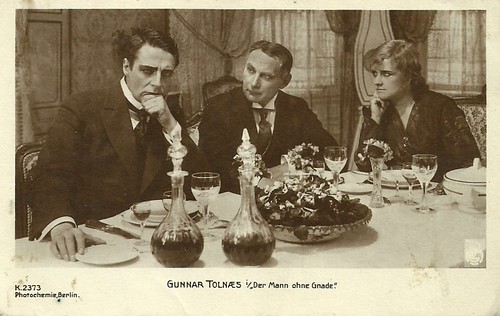
German postcard by Photochemie, no. K.2373. Photo: Nordisk Films. Gunnar Tolnaes in Den Retfærdiges Hustru (A.W. Sandberg, 1917), co-starring Else Frölich.
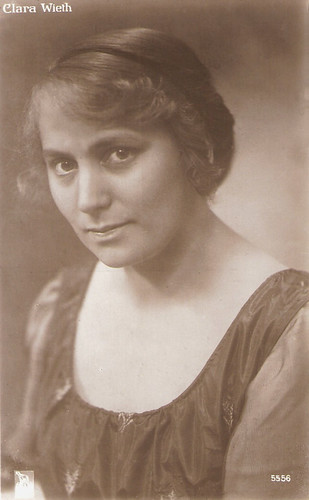
Clara Wieth. German postcard, no. 5556. Photo: Nordisk.

Latvian postcard, no. 13. Photo: Nordisk. Publicity still for Stodderprinsessen/Lumpen Princess (A.W. Sandberg, 1920) with Clara Wieth and Gunnar Tolnaes.
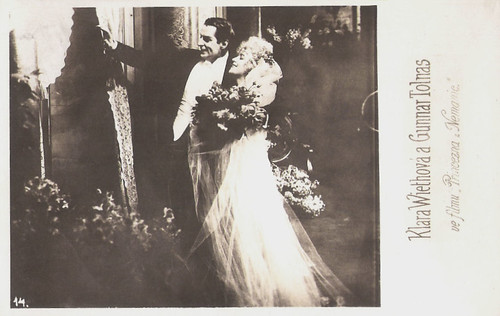
Latvian postcard, no. 14. Photo: Nordisk. Publicity still for Stodderprinsessen/Lumpen Princess (A.W. Sandberg, 1920) with Clara Wieth and Gunnar Tolnaes.
Clara Wieth (1883-1975), aka Clara Pontoppidan, was one the most active and popular actresses of the Danish silent cinema. Her breakthrough was with Den hvide Slavehandels sidste offer/The Last Victim of the White Slave Trade (August Blom, 1911), in which Clara plays an innocent girl who falls in the hand of white slavers who force girls into prostitution. Later she became a noted stage actress in Denmark and appeared in a number of Danish sound films.

Finnish postcard, no. 433. The postcard carries a stamp of the Finnish film inspection office. Photo: publicity still for the Charles Dickens adaptation Lille Dorritt/Little Dorrit (A.W. Sandberg, 1924), starring Karina Bell as Little Dorrit and Gunnar Tolnaes as Arthur Clennam.
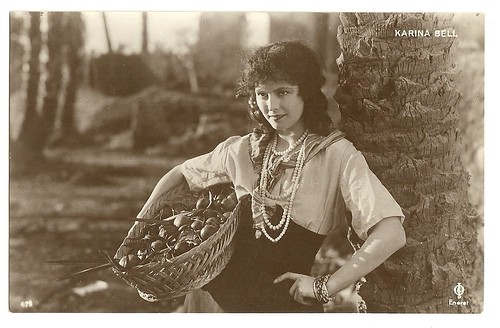
Danish postcard by Eneret, no. 629. Photo: Nordisk. Karina Bell in the romantic comedy Kan Kvinder fejle/Can women fail? (A.W. Sandberg, 1924), partly shot in Liguria, Italy.

German postcard by Ross Verlag, no. 1278/2, 1927-1928. Photo: Nordisk Film / Deutsch-Nordische Film-Union. Publicity still for Maharadjahens yndlingshustru III/The Maharaja's Favourite Wife III (A.W. Sandberg, 1926) with Karina Bell.
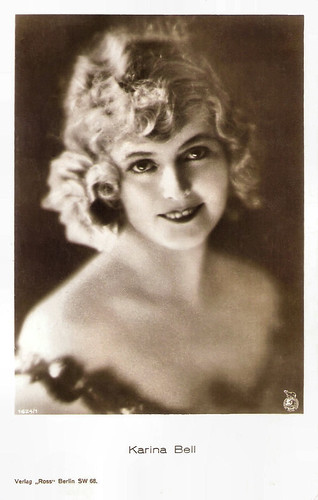
German postcard by Ross Verlag, no. 1624/1, 1927-1928. Photo: Nordisk Film. Publicity still for Klovnen/The Clown (A.W. Sandberg, 1926).
Charming Danish actress Karina Bell (1898-1979) was the most popular female star of the Nordisk Film Kompagni in the 1920s. The blond and slim actress was the beauty ideal of her generation. She also appeared in silent German and Swedish films. In later life she became the CEO of a Danish brewery.
In 1992, Nordisk merged with the Egmont media group and operates today as electronic media production and distribution group that employs 1,900 people. The total revenues in 2015 amounted to approximately €497 million. Today, Nordisk Film is the oldest film production company in operation in the world. Egmont Nordisk Film is the largest producer and distributor of electronic entertainment in the Nordic region.
The company produces and co-produces national and international feature films in Denmark, Norway and Sweden, which are distributed to cinemas around the Nordic countries, including Nordisk Film Cinemas in Denmark and Norway with 208 auditoriums. The films are also distributed internationally. Additionally, Nordisk Film produces animated content and feature films.
Through the Nordisk Film Foundation, Nordisk Film develop new talent. With an annual budget of approx. DKK 3.5 million, the Nordisk Film Foundation has also contributed to the development of the Danish film industry over the last 20 years by offering scholarships, project grants and awards. In 2015, the Nordisk Film Foundation launched the signature project 'The Polar Bear's Author Camp', bringing the total budget to EUR 4.5 million.
On 18 May 2012, Nordisk Film made a multi-year deal with Lionsgate to distribute their films (along with Summit Entertainment) in Scandinavia. In September 2012, DreamWorks signed a partnership with Nordisk Film for the distribution of DreamWorks' films in Scandinavia. On 31 March 2017, 20th Century Fox signed a distribution deal with Nordisk for Denmark and Sweden.

Dutch postcard. Photo: F.A.N. Film. Tove Maës in Ditte Menneskebarn/Ditte, Child of Man (Bjarne Henning-Jensen, 1946), released in the Netherlands as Ditte, een mensenkind.
Sources: Nordisk Film, Wikipedia and IMDb.

German postcard by Photochemie, Berlin, no. K 1617. Photo: Nordisk. Publicity still of Valdemar Psilander in Manden uden Fremtid/The man without a future (Holger-Madsen, 1916).

German postcard by Photochemie, Berlin, no. K. 1920. Photo: Nordisk Films. Gunnar Tolnaes in the Danish film Pjerrot (Hjalmar Davidsen, 1917).

German postcard by Photochemie, Berlin, no. K. 2149. Photo: Nordisk. Publicity still for Himmelskibet/Das Himmelschiff (Holger-Madsen, 1918) with Lilly Jacobsson as Marya, the Martian leader's daughter, and Gunnar Tolnaes as Avanti Planetaros.

Yugoslavian postcard by Edit. Cakovic, Zagreb, no. 3747/1. Photo: Mosinger Film. Publicity still for Klovnen/The Clown (A.W. Sandberg, 1926) with Karina Bell.

German postcard by Ross Verlag, no. 1623/1, 1927-1928. Photo: Nordisk. Publicity still for Klovnen/The Clown (A.W. Sandberg, 1926) with Gösta Ekman.
A polar bear atop a globe
In 1905, former circus impresario Ole Olsen (1863-1943) opened Biografteateret (The Biograph Theatre) - one of the first cinemas in Denmark - at Vimmelskaftet 47 in Copenhagen. A year later, Olsen began to produce films under the name of 'Ole Olsen’s Film Factory'. The first film is called Duer og måger/Pigeons and Sea Gulls (1906), a two minute reportage. However, right from the beginning dramatic films were made too – often starring the multi-talented draftsman, Robert Strom Petersen. 'Nordisk Films Kompagni' was officially founded on 6 November 1906. By the end of the year, the company has established offices at Vimmelskaftet, studios at a garden allotment in Valby, a copying lab in Frihavnen, an affilitate in Germany, an agent in Sweden – and a polar bear atop a globe as the company’s trademark.
Affiliates were established in Vienna and London in 1907. The film Løvejagten/Lion Hunting (Viggo Larsen, 1907) sold 256 copies and was very successful. However, as Ole Olsen refused to obey Minister of Justice, Alberti’s order to halt the shooting of Løvejagten in the wake of an animal cruelty charge, he lost his cinema license for 'Biografteatret'. Olsen just slipped the film across the border and premiered it in Sweden. Løvejagten/Lion Hunting was a huge international success and set Nordisk on its path to glory.
Nordisk continued to grow rapidly. In 1908, Studio 1 in Valby was opened, and the New York affiliate, 'Great Northern Film Company', was established. The opening of Studio 2 in Valby followed in 1910. The Aarhus-based company 'Fotorama' introduced multi-reel films with Den hvide slavehandel/The White Slavery Trade (1910). Ole Olsen adapted the idea by copying the Fotorama-film nearly shot by shot (and adding 100 meters). August Blom directed this film, which was also called Den hvide Slavehandel.
The same team of Løvejagten, writer Arnold Richard Nielsen, director/star Viggo Larsen and cinematographer Axel Graatkjær (Axel Sørensen), had already made a film titled Den hvide Slavinde (Viggo Larsen, 1907), about women being kidnapped and forced to prostitution.
Blom's lurid piece of sensationalism set off another international film fad, caused all sorts of rumpus over censorship and even contributed to a change in the law in the US (the Mann Act). A year later, Olsen committed Nordisk Films Kompagni – as the first company in the world to produce multi-reel films of approx. 45 minutes duration. In the same year, Blom directed the sequel Den hvide Slavehandels sidste Offer, starring Clara Wieth Pontoppidan.
Nordisk Film became a public company, and Ole Olsen acquired the title of managing director (1911-1922). The actor Valdemar Psilander appeared in his first Nordisk Film feature, Ved fængslets port/Temptations of a Great City (August Blom, 1911). At the end of 1916, he had made more than eighty Nordisk Film features and was considered to be one of the greatest (and best paid) film stars of his time. Yet by the end of 1916, Psilander was demanding a salary of DKK 250,000 (34,000 EUR), which forced Nordisk Film into decline. The following year, Psilander suddenly passed away. Other major Nordisk film stars were Olaf Fønss, Clara Wieth Pontoppidan and the Norwegian Gunnar Tolnaes. Asta Nielsen also made two of her total of four Danish films for Nordisk Film: Balletdanserinden/The Ballet Dancer (August Blom, 1911), and Mod Lyset/Towards the Light (Holger-Madsen, 1919).
In 1912, Studio 3 in Valby was opened, and in 1914 Studio 4. Carl Th. Dreyer became a screenwriter and script consultant at Nordisk. In 1918, he directed his first film Præsidenten/The President, which premiered in Sweden in 1919 and Denmark in 1920. His ambitious film, Blade af Satans bog/Leaves from Satan’s Book premiered in 1921.

Else Frølich/Else Frölich. German postcard, no. 7482. Photo: Nordisk.

Else Frølich/Else Frölich. Danish postcard. Photo: Nordisk.

Austrian postcard by Edition Projectograph A.G., no. B.K.W.I. Kino 25. Photo: publicity still from Gæstespillet/Guest Game (Eduard Schnedler-Sørensen, 1913).
In the 1910s, Else Frølich/Else Frölich (1880-1960) was one of the leading actresses of the Danish Nordisk Company. She played in many Nordisk films and was often paired with the biggest male star of those years, Valdemar Psilander (1994-1917), such as in the beautifully restored Evangelimandens liv/The candle and the moth (Holger-Madsen, 1915). Frölich also often played in vehicles designed for herself.

German postcard by Photochemie, Berlin, no. K 1510. Photo: Nordisk Films.
Betty Nansen (1873-1943) was a Danish stage and film actress who worked from 1913 on with prominent directors like August Blom, Holger Madsen and Robert Dinesen. Later she became the director of the theatre that still carries her name, the Betty Nansen Theatre.

German postcard by Photochemie, Berlin, no. K. 1766. Photo: Nordisk.
Carlo Wieth (1885-1943) was a Danish actor, who starred in Danish and Swedish silent cinema of the 1910s and early 1920s, often paired with his then wife Clara (Pontoppidan) Wieth. After his start at Kinografen with Ekspeditricen/Salesgirl (August Blom, 1911), he played in some 18 films for Nordisk Film. With his somewhat boyish appearance and his fresh but gentle acting style, he soon became a popular actor.

German postcard by Photochemie, Berlin, no. K. 1662. Photo: Nordisk. Publicity still for Pjerrot/Pierrot (Hjalmar Davidsen, 1917) with Zanny Petersen and Gunnar Tolnaes.

German postcard by Photochemie, Berlin, no. K. 1768. Photo: Nordisk Film.
Zanny Petersen (1892-1976) was a Danish stage and screen actress, who starred in Danish silent film since 1911. Between 1912 and 1917, she appeared in 40 films for Nordisk Film.
Huge and expensive costume dramas
In 1914, the peak of silent film production at Nordisk Films Kompagni was reached. 143 fiction and 46 non-fiction features were produced that year, and more than 7000 copies were sold. A year later, Studio 5 in Valby was opened, but the following year the New York affiliate was shut down.
World War I badly affected film distribution in Europe. The Russian market closed its borders due to the 1917 Revolution. Ole Olsen relinquished his German interests, now including sixty cinemas, a production company and various assets with a cumulative share capital of 30 million marks. Production was in decline and Nordisk Film lost millions.
Talented people left the company, including Lau Lauritzen, who directed more than 200 Nordisk Film faces. At Palladium, he created the biggest Danish film success of the 1920s: Fy og Bi (Fyrtårnet og Bivognen), the most famous comedy couple of the European silent cinema. Long Carl Schenstrom and short Harald Madsen became a hit with their short slapstick films, known under such different names as Pat & Patachon, Long & Short or Watt & Half-Watt.
A.W. Sandberg, who had been a successful director at Nordisk Film since 1914, became head of the production department in 1922. Throughout the 1920s, he directed a number of huge and expensive costume dramas, including the famous Charles Dickens’ adaptions, David Copperfield (A.W. Sandberg, 1922) and Lille Dorrit/Little Dorrit (A.W. Sandberg, 1924) with Karina Bell.
In 1923, H. Bloch-Jespersen became managing director of Nordisk Films Kompagni (1924-1926). From 1926 on, Nordisk Films Kompagni was controlled by the board. In 1928 Nordisk Films Kompagni suspended payments. At a general meeting it was decided that the company should be liquidated. In 1929 a wealthy stockbroker, Carl Bauder – the majority shareholder of both Nordisk and the Palads Teatret cinema since 1926 – acquired all the assets and reorganised the company under the name ‘Nordisk Films-Kompagni af 1929’. The company was known as ‘Nordisk Tone-film’ until the end of 1935, after which it reverted to its original name, Nordisk Films Kompagni.

German postcard by Photochemie, no. K. 1913. Photo: Nordisk Films. Gunnar Tolnaes in Pjerrot (Hjalmar Davidsen, 1917), with Ulla Nielsen as The Child.

German postcard by Photochemie, Berlin, no. K. 3008. Photo: Nordisk. Lilly Jacobson in Maharadjahens Yndlingshustru/The Maharaja's Favourite Wife (Max Mack, 1917).

German postcard by Ross Verlag, no. 50/1. Photo: Deutsch Nordische Film Union / Nordisk. Gunnar Tolnaes in Maharadjahens Yndlingshustru/The Maharaja's Favourite Wife (Max Mack, 1917).
Gunnar Tolnaes (1879-1940) had his most famous performance as an Indian prince in the Danish orientalist melodrama Maharadjahens Yndlingshustru/The Maharaja's Favourite Wife (Max Mack, 1917), with Lilly Jacobson. It was so popular that it had a Danish sequel in 1919, and a German sequel in 1921.

German postcard by Photochemie, Berlin, no. K. 1854. Photo: Nordisk Films. Valdemar Psilander and Gudrun Houlberg in Klovnen/The Clown (A.W. Sandberg, 1917).

German postcard by Photochemie, Berlin, no. K.1915. Photo: Nordisk Films. Valdemar Psilander in Der gefesselte Sieger (The conqueror in chains), the German release title for Hvorledes jeg kom til filmen/The Mute (Robert Dinesen, 1919). Psilander plays a star of the silent pictures, so basically himself.

German postcard by Photochemie, Berlin, no. K. 1916. Photo: Nordisk Films. Valdemar Psilander and Ebba Thomsen in Das zweite Ich, German release title for Lykken/The Road to Happiness (Holger-Madsen, 1918).

German postcard by Photochemie, Berlin, no. K. 1932. Photo: Nordisk Films. Valdemar Psilander in Lydia (Holger-Madsen, 1918).

German postcard by Photochemie, Berlin, no. K. 1939. Photo: Nordisk Films. Valdemar Psilander in Das geheimnis des Sphinx, German release title for the Danish silent film Sfinxens Hemmelighed/The Secret of the Sphinx (Robert Dinesen, 1918).

German postcard by Photochemie, Berlin, no. K. 1944. Photo: Nordisk Films. Valdemar Psilander in Rytterstatuen/For the king's statue (A.W. Sandberg, 1919). The German title is Um das Bild des Königs.

German postcard by Photochemie, Berlin, no. K. 2628. Photo: Nordisk Films. Publicity still of Valdemar Psilander and Gudrun Houlberg-Nissen in Kærlighedsleg/Der Ewige Rausch/Love (A.W. Sandberg, 1918).
Valdemar Psilander (1884-1917) was the most popular male actor in the Danish cinema of the 1910s. The charismatic Psilander took the German, Russian and Hungarian audiences by storm. At Nordisk he would play in six years in 83 films. Only 32 years old, Valdemar Psilander passed away in 1917. At the peak of his career. Some say he died of a cardiac affliction, others say it was suicide.
Insufficiently pro-German
Before, during and after the Nazi-German occupation of Denmark, Germany was one of the Danish film industry’s main trade partners. The scarcity of American films during the occupation opened up opportunities for Danish and German films. Carl Bauder, Nordisk Film’s shrewd owner, attempted unsuccessfully to monopolise German film distribution during the early years of the occupation. He failed because Nordisk Film was probably considered insufficiently pro-German. Like everyone else in the Danish film industry, Nordisk Film did business with the Germans during the occupation. Nordisk Film’s factory in the Frihavnen district of Copenhagen had a contract to copy German films, Nordisk Film rented out staff to produce the weekly newsreel Ugerevyen, and the company also exported Danish films to Germany.
During the occupation, Germans bombed the film studios in Valby, and Kino-Palæet (Nordisk Film’s cinema operating under Bauder’s licence) suffered extensive damage after being hit. In 1946, the rebuilt studio 4 was reopened. Erik Balling and Ove Sevel were employed as assistant directors. Balling later became director, screenwriter, producer and in 1957, his film Qivitoq (Erik Balling, 1957) was nominated for an Oscar. He became managing director of Nordisk Films Kompagni A/S from 1957 till 1989. In 1968, he had a box office hit with the comedy Olsen BandenThe Olsen Gang (Erik Balling, 1968). Two years later, he directed Huset på Christianshavn/Friends and Neighbours (Erik Balling, 1970-1977), a TV series in 84 episodes and the first fiction of the studio produced specifically for TV. While other film production companies shut down, Nordisk Film profited greatly on the TV series and avoided cutting down staff.
In the period 1971-1981, an 'Olsen Banden' film was produced every summer. The Olsen Gang became one of Denmark’s greatest film hits ever. In 1972, Studio 3 was rebuilt and became the biggest studio in Valby. Erik Balling made Matador/Monopoly (1978-1982) a TV series of 24 episodes which became the greatest TV success in Denmark to date. New directors such as Bille August, Kaspar Rostrup and Nils Malmros were making award-winning films at Nordisk.
In 1984, the young director Lars von Trier directed his first feature Forbrydelsens Element/The Element of Crime. The film won the Grand Prix du technique, Cannes, seven Danish Robert statuettes, and other awards. Another award winner was Tro, Håb og Kærlighed/Twist and Shout (Bille August, 1984). In 1987 followed Babettes Gæstebud/Babette’s Feast (Gabriel Axel, 1987), starring Stéphane Audran, which won the Academy Award for Best Foreign Film (1988), the first ever Danish Oscar.
The following year, Pelle Erobreren/Pelle the Conqueror (Bille August, 1988) won also the Academy Award for Best Foreign Film (1989), plus the Palme d´Or in Cannes, a Golden Globe Award, and eight Robert statuettes. Europa (Lars von Trier, 1991) with Barbara Sukowa and Jean-Marc Barr, was also awarded many prestigious prizes, including the Prix de la Commision & Special Prize in Cannes.

German postcard by Photochemie, Berlin, no. K. 2160. Photo: Nordisk. Publicity still for Himmelskibet/Das Himmelschiff (Holger-Madsen, 1918) with Gunnar Tolnaes as Avanti Planetaros.

German postcard by Photochemie, no. K. 2372. Photo: Nordisk Films. Gunnar Tolnaes in Den Retfærdiges Hustru (A.W. Sandberg, 1917), co-starring Else Frölich.

German postcard by Photochemie, no. K.2373. Photo: Nordisk Films. Gunnar Tolnaes in Den Retfærdiges Hustru (A.W. Sandberg, 1917), co-starring Else Frölich.

Clara Wieth. German postcard, no. 5556. Photo: Nordisk.

Latvian postcard, no. 13. Photo: Nordisk. Publicity still for Stodderprinsessen/Lumpen Princess (A.W. Sandberg, 1920) with Clara Wieth and Gunnar Tolnaes.

Latvian postcard, no. 14. Photo: Nordisk. Publicity still for Stodderprinsessen/Lumpen Princess (A.W. Sandberg, 1920) with Clara Wieth and Gunnar Tolnaes.
Clara Wieth (1883-1975), aka Clara Pontoppidan, was one the most active and popular actresses of the Danish silent cinema. Her breakthrough was with Den hvide Slavehandels sidste offer/The Last Victim of the White Slave Trade (August Blom, 1911), in which Clara plays an innocent girl who falls in the hand of white slavers who force girls into prostitution. Later she became a noted stage actress in Denmark and appeared in a number of Danish sound films.

Finnish postcard, no. 433. The postcard carries a stamp of the Finnish film inspection office. Photo: publicity still for the Charles Dickens adaptation Lille Dorritt/Little Dorrit (A.W. Sandberg, 1924), starring Karina Bell as Little Dorrit and Gunnar Tolnaes as Arthur Clennam.

Danish postcard by Eneret, no. 629. Photo: Nordisk. Karina Bell in the romantic comedy Kan Kvinder fejle/Can women fail? (A.W. Sandberg, 1924), partly shot in Liguria, Italy.

German postcard by Ross Verlag, no. 1278/2, 1927-1928. Photo: Nordisk Film / Deutsch-Nordische Film-Union. Publicity still for Maharadjahens yndlingshustru III/The Maharaja's Favourite Wife III (A.W. Sandberg, 1926) with Karina Bell.

German postcard by Ross Verlag, no. 1624/1, 1927-1928. Photo: Nordisk Film. Publicity still for Klovnen/The Clown (A.W. Sandberg, 1926).
Charming Danish actress Karina Bell (1898-1979) was the most popular female star of the Nordisk Film Kompagni in the 1920s. The blond and slim actress was the beauty ideal of her generation. She also appeared in silent German and Swedish films. In later life she became the CEO of a Danish brewery.
The Polar Bear's Author Camp
In 1992, Nordisk merged with the Egmont media group and operates today as electronic media production and distribution group that employs 1,900 people. The total revenues in 2015 amounted to approximately €497 million. Today, Nordisk Film is the oldest film production company in operation in the world. Egmont Nordisk Film is the largest producer and distributor of electronic entertainment in the Nordic region.
The company produces and co-produces national and international feature films in Denmark, Norway and Sweden, which are distributed to cinemas around the Nordic countries, including Nordisk Film Cinemas in Denmark and Norway with 208 auditoriums. The films are also distributed internationally. Additionally, Nordisk Film produces animated content and feature films.
Through the Nordisk Film Foundation, Nordisk Film develop new talent. With an annual budget of approx. DKK 3.5 million, the Nordisk Film Foundation has also contributed to the development of the Danish film industry over the last 20 years by offering scholarships, project grants and awards. In 2015, the Nordisk Film Foundation launched the signature project 'The Polar Bear's Author Camp', bringing the total budget to EUR 4.5 million.
On 18 May 2012, Nordisk Film made a multi-year deal with Lionsgate to distribute their films (along with Summit Entertainment) in Scandinavia. In September 2012, DreamWorks signed a partnership with Nordisk Film for the distribution of DreamWorks' films in Scandinavia. On 31 March 2017, 20th Century Fox signed a distribution deal with Nordisk for Denmark and Sweden.

Dutch postcard. Photo: F.A.N. Film. Tove Maës in Ditte Menneskebarn/Ditte, Child of Man (Bjarne Henning-Jensen, 1946), released in the Netherlands as Ditte, een mensenkind.
Sources: Nordisk Film, Wikipedia and IMDb.
2 comments:
These are truly beautiful and there may be a Nordisk film I overlooked when writing my webpage that you have included. Thank you very much.
Thanks, Scott!
Post a Comment